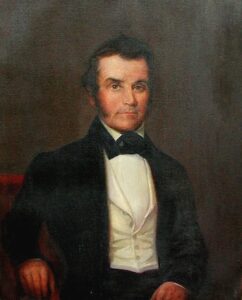
Isaac Franklin
*Isaac Franklin was born on this date in 1789. He was a white-American slave trader and plantation owner.
Isaac Franklin was born in Sumner County, TN, to Mary (née Lauderdale) and James Franklin Sr., who came from western North Carolina. James Franklin Sr. served Lord Dunmore during the American Revolutionary War and assisted in the construction of frontier forts. He married Mary Lauderdale, his employer's daughter, when she was 13 years old. The two would go on to have nine children.
Following a land grant for his Revolutionary War service by the North Carolina Assembly, James Franklin amassed hundreds of acres of property along the north shore of the Cumberland River and a significant number of enslaved Africans. By the end of the 1810s, he owned 26 enslaved people. The Cumberland was an early center of the regional slave trade during the first decade of the 1800s, with slaves commonly leased, used to pay debts, purchase property, given as prizes for lotteries, or as gifts for children. Franklin's property, including his slaves, was portioned among his children following his death in 1828.
Isaac Franklin attended a rural school while working on his father's farm as a child. With the outbreak of the War of 1812, he joined an outfit of the Tennessee militia in the fall of 1813, which eventually became part of the 2nd Regiment of Volunteer Mounted Riflemen in the Creek War. Franklin was promoted to lieutenant and served under Andrew Jackson's command at Talladega. He left the army in 1814, and in 1815, he settled in a 132-acre plot five miles west of Gallatin, Tennessee, purchased from his father.
Franklin returned to slave trading soon after the War, buying slaves in Virginia and Maryland before marching them in coffles for sale at Natchez, Mississippi. He introduced John Armfield to the slave trade, and on February 28, 1828, the Franklin & Armfield partnership was officially formed, with the agreement renewed every five years. Although the original "articles of co-partnership" have been lost, both men likely contributed upwards of $10,000 to the partnership. The agreed business structure placed Franklin in command of sales in Natchez, with Armfield stationed permanently at Alexandria to make purchases. Smith Franklin left Isaac's employment, although it is unknown if this was related to the formation of the partnership.
Franklin & Armfield built a base of operations in Alexandria, D.C., where Franklin's elder brothers had previously worked as slave traders. The location avoided direct competition with a rival slave trader in Baltimore. During his partnership, Franklin mainly managed slave sales in the Lower Mississippi. Many rival slave traders were either pushed out of the market or hired as purchasing partners for the company, further expanding its corporate reach. By the time of his death from a stomach illness in April 1846, he owned 646 enslaved people.
In addition to plantation slaves and house servants, Franklin & Armfield trafficked sex slaves, often referred to as "fancy maids" or "fancy girls." Mixed-race women, especially "nearly white" quadroons and octoroons, were considered especially desirable for sexual slavery, selling for prices four to five times that of field laborers. Exceptionally light-skinned sex slaves were valued by planters and referred to as white when sold by Franklin. Sex slaves were traded between members of the firm for their use, sexually abusing women in their possession. Franklin was "focused on" a sex slave named Lucinda Jackson or "Lucindy" after purchasing her at a company discount in 1834, impregnating her shortly before his marriage. Franklin quickly sold her to a friend in Louisville to avoid scandal.
Franklin took a dim view of romantic relationships with slaves, mocking Ballard for freeing two enslaved women with whom he had children. Franklin began a relationship with Adelicia Hayes, nearly thirty years his junior, the daughter of a wealthy Tennessee planter and minister. On July 2, 1839, Franklin married Hayes at her family's Rokeby Plantation, and they had four children together. Various health issues, especially stomach problems, plagued Franklin later in life. In late April 1846, he fell gravely ill and died on April 27, 1846.
In his will, he ordered the construction of a mausoleum for himself and his family. He also set aside a portion of his estate to purchase 190 slaves for his West Feliciana properties, housed by constructing three additional "clusters of houses." Armfield spent several years executing Franklin's estate, including some management of his plantations.